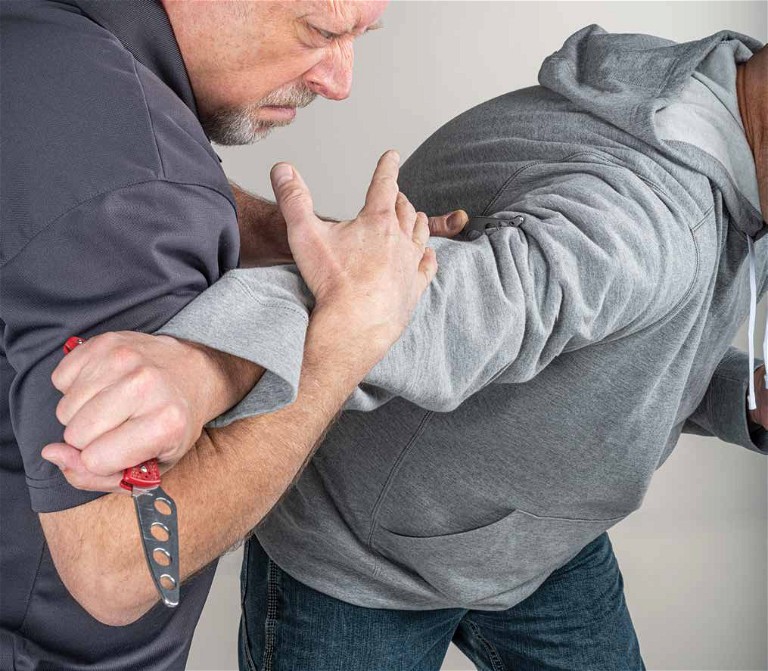DEFENSIVE EDGE MICHAEL JANICH
‘LIVE-HAND PASSING’ STRATEGY
KNIFE TACTICS FOR AND AGAINST LEFTIES

Being left-handed can be challenging. Besides having to creatively cope with all the tools and other products that are purpose-built for the right-handed majority, left-handers also have to adapt their physical skills to a right-biased world. From a firearm-based self-defense perspective, this isn’t usually a big deal. Since guns offer the benefit of distance, whether you squeeze the trigger right- or left-handed doesn’t really matter. However, once you get into the realm of contact-distance tactics, the plot thickens considerably. Either you end up like many martial arts systems — struggling to do everything ambidextrously and not doing any of it particularly well — or you’re stuck with a practical, dominant-hand-biased system that focuses on using the “wrong” hand.
Fortunately, just as southpaw boxers can learn to be highly competitive against orthodox opponents, lefties can also learn to defend themselves effectively. The key — especially when it comes to self-defense with edged weapons — is to start with a firm grasp of reality and a sound strategy.
MISMATCHED LEADS
Practical self-defense should focus on preparing for what is most likely to happen. For lefties, who account for about 10 percent of the population, that means most likely facing a right-handed attacker. In the Martial Blade Concepts (MBC) system, we refer to this context as “mismatched leads.” If you’re a natural lefty, it applies with a vengeance. However, even if you’re right-handed, it’s still very relevant. While statistically most of the assailants you might face will be right-handed, the possibility of a left-handed attack is still very real. In that context, the content of this article still applies to you, but in a mirror-image format.
If you’re a regular reader of Defensive Edge, you may remember that we’ve explored the topic of mismatched leads before (in the February/March 2019, February/March 2021 and October 2021 issues of Concealed Carry Magazine). This time, however, we’re going to take a different approach based on MBC’s brother system of Counter-Blade Concepts (CBC).
CBC focuses on unarmed defenses against edged-weapon attacks. One of the key principles of the system is using the backs of the forearms as your primary defensive tools. Unlike the inner forearms and wrists, which contain key arteries and the flexor muscles and tendons that enable your hands to grip things (like weapons), the outer surfaces are less target-rich. That means they can be used to block, deflect and redirect attacks with less concern for suffering a disabling cut or puncture.

DEFEND WITH WHAT YOU HAVE
The backs of the forearms defend the tendons and flexor muscles on the insides of the arms.
THE ‘PASSING DRILL’
One of the core skill-development drills in CBC is the “Passing Drill.” In this drill, your partner initially attacks with a sequence of Angle 1 (high-right forehand), Angle 2 (high-right backhand), Angle 3 (low-right forehand) and Angle 4 (lowright backhand) strikes. As he delivers each strike, you pivot your upper body to face the attack and intercept it with the back of the forearm of the arm closest to him. For example, against an Angle 1, you would pivot to your left and intercept his right arm with the back of your right forearm. You would then pivot your body to the right and, while maintaining firm pressure against his arm, “pass” his arm across to the right side of your body.
When he attacks with an Angle 2, you would do the mirror image, using your left forearm to intercept his arm and “pass” it across to the left side of your body. The concept is the same for the low-line angles, except you would block with the back of your left arm — pointed downward — first, and then pass his arm with your right. For Angle 4, you would block with the back of your right forearm and pass with your left. If this seems confusing, watch the companion video to this article and you will quickly understand.

WATCH THE VIDEO TUTORIALyoutu.be/ZR 8D5OJBYJ8
THE ‘LIVE-HAND PASS’
By using the concept of the “Passing Drill” as a foundation, lefties can easily create a strategy that allows them to defend against typical right-handed attacks. Since the knife will be in your dominant left hand, your right hand is considered your “live” hand, and it will do the passing.
Against an Angle 1 attack, which targets the upper-right quadrant of your body, intercept the attacking arm with the back of your right forearm. Ensure you make contact between the assailant’s elbow and wrist. Using the same skill as in the “Passing Drill,” pass the arm across your body to your right. As his arm reaches the right side of your body, shuffle or step forward and bring your right palm to your chest to trap it securely against your body. As you do this, place the edge of your knife against the back of his triceps muscle. Keeping your elbow tight to your ribs, drop your body weight and pressure-cut through his triceps. This will destroy that arm’s ability to extend at the elbow joint and ideally sever the radial nerve, compromising his grip.
Follow through on your cut to chamber your knife at your left hip. From there, thrust into the inside of the attacker’s right knee. Rotate your hand from palm down to palm up and sink your body weight as you sever the top of his calf muscle. As he collapses to that knee, follow with a second body-weight-powered cut to his Achilles tendon. These cuts will destroy his ability to stabilize his ankle and create an instant “mobility kill,” allowing you to break contact and create distance.
Just like the “Passing Drill,” you can use the Live-Hand Pass against a low-line Angle 3 strike by blocking first with the back of your left arm and then passing the attacking arm with your right forearm. From there, the rest of the technique is exactly the same.
While not suitable against long weapons, the Live-Hand Pass is a simple strategy that gives knife-armed lefties a serious fighting chance against the most common street attacks. It’s also a viable solution for righties against left-handed assailants.